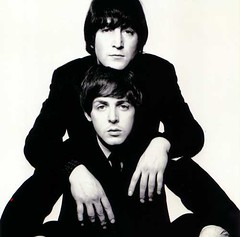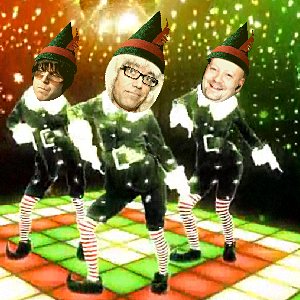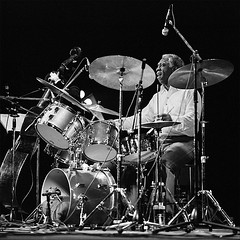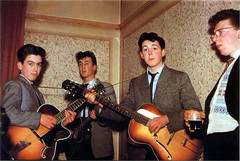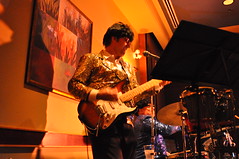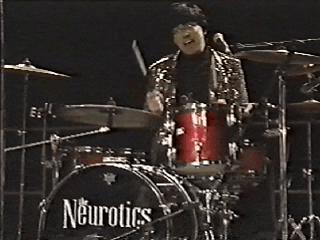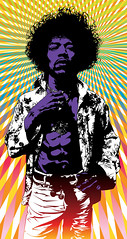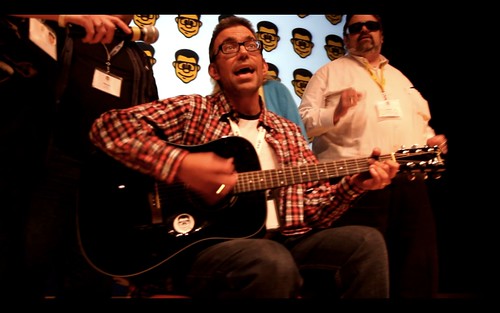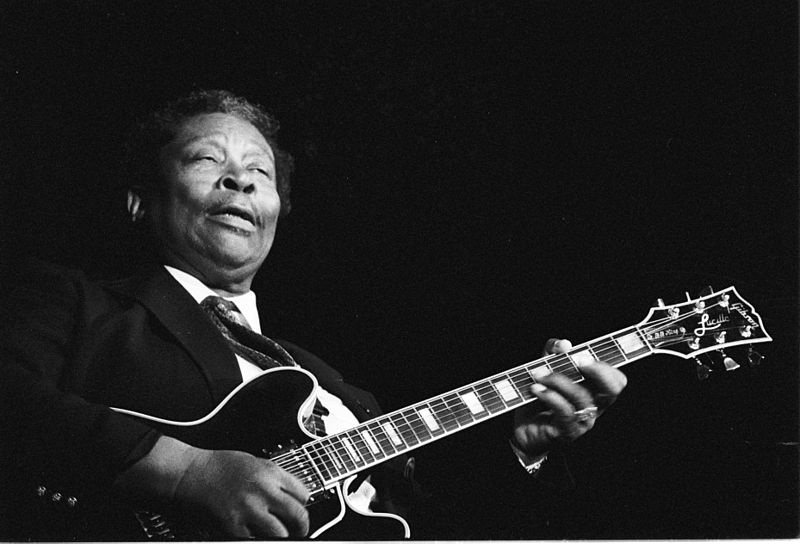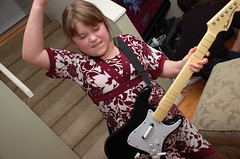A few weeks ago I joined a Facebook trend and posted the first 16 music albums (rather than 15) that came to mind as influential, and that will "always stick with me." But, given how quickly I posted them, I didn't say why, or think about it much. So I might as well explain them now. Again, I'm listing the albums alphabetically by artist:
Art Blakey and The Jazz Messengers - Drum Suite (1957): This first choice is also perhaps my oddest, since I'm not much of a jazz listener, I don't own this album, and I haven't even heard it in full for at least 20 years, possibly 30. But it—and especially the first track, "The Sacrifice"—are embedded deep in my childhood subconscious. My dad owns the LP, and as a very young child I used to ask him to play it from time to time, both because it was exciting and energizing and because it freaked me out a bit. "The Sacrifice" begins with a distant, spooky chant in Swahili, then launches into an intense seven minutes of African drumming, punctuated by Blakey's full-tilt accompaniment on his drum kit. The rest of the album includes more excellent Afro-Cuban jazz, as well as some straight-ahead bebop in Blakey's more usual style. Back in 1957, it was pioneering, World Music long before the term was coined. But I simply loved (and feared) the sounds and the rhythms, and now that I think of it, Drum Suite is probably a major reason I like much of the other music I do (including some below), and might be part of why I became a drummer myself many years later. I need to go buy it again.
The Beatles - Revolver (1966): No mystery here. The Beatles were the greatest rock-n-roll band of all, and once I became a drummer, I played a lot of their music in concerts for 20 years, so I got to know it very well. While I love their brash and exuberant early work (from "I Saw Her Standing There" to "A Hard Day's Night"), as well as much of their later material (including "Strawberry Fields Forever," "Hey Jude," "I Am the Walrus," and "Get Back"), I've always preferred the band's 1965–66 middle period. With the albums Help!, Rubber Soul, and Revolver, the Beatles took the basic concept of the pop song as far as it could go. And whenever I play Revolver (and Rubber Soul too), I'm astonished that all those great tunes appeared on a single disc: it's like a Beatles Greatest Hits record, except it was simply what they managed to record as their new material from April to June 1966 (plus a little single featuring "Paperback Writer" and "Rain" too), before embarking on their final concert tour. Almost 45 years later, it remains a landmark and a masterpiece that can inspire (or depress) any songwriter or musician who hears it.
Crowded House - Woodface (1991): From 1986 to 1996, Crowded House were the best pop band in the world, I think. And while the band's 1988 predecessor, Temple of Low Men, is probably overall a stronger collection, showcasing the always-brilliant songwriting of leader and singer Neil Finn, Woodface is more sprawling, more interesting, funnier, and includes its own roster of supremely written and performed songs, featuring Neil's wonderful harmony singing with his brother Tim, who was a member of the group for these sessions only. "It's Only Natural," "Fall at Your Feet," "Weather With You," and "Four Seasons in One Day" are compositions even Lennon and McCartney might envy. Plus my friend Alistair had the cassette of Woodface as the only music on his car stereo for at least a year, yet somehow we never tired of it.
James Brown - Star Time (box set, 1991): Maybe box sets are cheating in a list of albums, but I don't care. You can't contain James Brown in a single disc anyway. Here's what Rolling Stone said about this set: "James Brown can seem like an insufferable braggart. He makes no bones about his greatness, proclaiming himself not only the King of Soul but the inventor of funk and the progenitor of rap and disco—not to mention a leading exponent of black pride. To hear him tell it, James Brown is one of the most dynamic and visionary musicians America has ever produced. After examining the evidence set forth in the seventy-two songs on Star Time, however, only one conclusion is possible: James Brown is far too modest." I was no Brown expert at the time I first picked up the box when it was released, but I played its tracks over and over again for years afterwards. Presented chronologically, they show how Brown took his manic R&B stage show of the 1950s and stripped it down into a series of the tightest, leanest, most cutting bands in history, creating funk and transforming songs and music and voices into pure rhythm. Music (and, after listening, my sense of it) hasn't been the same since.
Led Zeppelin (1969): All the bluster and bombast, instrumental and vocal skill, unabashed musical thievery, heavy-metal invention, explosive sexuality, and blues–folk–Eastern mashupness that Led Zeppelin would unleash over the next decade are there in their first album, recorded with minimal equipment after these four British youths had discharged their obligations touring as the final incarnation of the Yardbirds. With it and Led Zeppelin II, they put the exclamation mark on the unequalled musical and cultural transformations of the 1960s. And the first track, "Good Times Bad Times," introduced the world to the terrifyingly excellent drumming of John Bonham. Most drummers, myself included, still can't play it properly.
Massive Attack - Mezzanine (1998): My friend Tara bought me this album, from a group and a trip-hop genre I knew basically nothing about, and I was instantly hooked. Everyone has heard tracks from it now, with "Teardrop" becoming the theme for the TV series House, and other tracks being used in The Matrix and The West Wing. But potential overexposure hasn't depleted the dark power of these songs, and the extraordinary production that makes them entirely immersive, especially in headphones with the lights low. Mezzanine also finally convinced me that music driven by samples and loops wasn't a cheat of some kind, and could truly be newly creative.
Midnight Oil - Scream in Blue Live (1992): I'm not sure why my two favourite bands of the '80s and early '90s (Midnight Oil and Crowded House) both formed in Australia. Crowded House had more finely crafted songs, but the Oils were by far the most powerful live act I've ever seen. While a Crowded House performance was (and is) full of jokes and silliness and fun, witnessing Midnight Oil and their spastic, fearsome lead singer Peter Garrett was more like entering a war zone. (Less fearsomely, Garrett is now the Education Minister in Australia's federal governemnt.) This disc documents that assault, compiling live tracks from 1982 to 1992. Live albums are often money-grubbing afterthoughts, but not Scream in Blue: more than any record except perhaps Live at Leeds (see below), it captures all the force and passion that an unstoppable freight train of a rock band can muster with some guitars, drums, and singing. Released at the height of the distortion-heavy grunge movement emerging from Seattle, this CD prompted another gem from a Rolling Stone reviewer: "Never mind the Puget Sound, this is real guitar nirvana."
Nuggets: Original Artyfacts from the First Psychedelic Era, 1965–1968 (box set, 1998): Another box set, this time four discs of one-hit wonders and other oddities from one of the golden ages of popular music: the DIY American garage-rock 1960s inspired by Beatlemania. You've got the extraordinary Fab Four knock-offs the Knickerbockers and "Lies," Todd Rundgren's original band Nazz and "Open My Eyes," "Incense and Peppermints" from the Strawberry Alarm Clock, "Woolly Bully," "Louie Louie," Creedence Clearwater Revival when they were called the Golliwogs, and dozens and dozens of other bands made up of usually barely competent musicians who somehow stumbled their way (for a song or two) into genius and then stumbled back into real life (perhaps Vietnam), inspiring countless other punk and New Wave and garage bands for decades to come. "Buy some cheap gear at the pawn shop and start rocking!" they beckoned. And many of us did.
Odds - Bedbugs (1993): One of the bands inspired by those '60s garage rockers was Vancouver's own Odds, formed in the late 1980s and supporting themselves as the classic rock cover act the Dawn Patrol for years before backing up Warren Zevon, releasing four great albums in the '90s, and then folding (and reforming a couple of years ago). I like Bedbugs best, with the singles "It Falls Apart" and "Heterosexual Man" being hits in Canada, and the rest of the tracks simply being great big slabs of clever guitar-powered pop-rock. I became an acquaintance, sometimes bandmate, and friend of these guys (especially bassist Doug Elliott, who over the years played on and off with my cover band the Neurotics and even helped me create a short little instrumental tune for my podcast), but I started as, and remain, a fan. They're a great live band too.
Peter Gabriel - Peter Gabriel 4, a.k.a. Security (1982): I didn't realized it until I made this list, but this album's first track, "The Rhythm of the Heat," bears a strong resemblance to Art Blakey's "The Sacrifice," discussed up above. There's no jazz drumming and it's loaded with bizarro electronic noises from the Fairlight CMI sampler, true, but Gabriel's song skeeves me out in a similar way and ends with an African percussion freakout that would fit right in on Drum Suite. Of course I came to Security by seeing and hearing "Shock the Monkey" on TV (recommended on Canadian VJ Terry David Mulligan's TV show by Duran Duran, of all acts), so I already knew Peter Gabriel might be a bit insane, but I fell in love with it because of that insanity, and the strange, shivery, hacked-together feeling of the music. In fact, it was one of the first discs to be recorded, mixed, and mastered entirely on digital equipment, so many of the tracks were assembled rather than really recorded, and Gabriel took full advantage of that technology to create something that sounded genuinely new. Plus the cover art remains scary and entirely incomprehensible.
The Police - Synchronicity (1983): The unavoidable monster hit album of 1983 and 1984, and the one that finally sent the Police on their separate ways until the reunion tour of 2007. I was 14, and I listened to it so much that I can still pretty much replay the whole LP (plus the bonus track "Murder By Numbers") in my head from memory, something I sometimes did while riding my bike to UBC years later, before the era of the iPod. Even though much of the reggae stylings and silly humour of their earlier work were gone by this time, Synchronicity was proof that the best bands really are alchemy. Sting wrote and played bass and sang the songs, but he was never again anything close to as good as when Stewart Copeland was drumming and Andy Summers was playing guitar and they all hated each other and got into fistfights and arguments and yet crafted gorgeous and memorable recordings like "Synchronicity II" and "Every Breath You Take" and "Wrapped Around Your Finger."
Robert Johnson - The Complete Recordings (box set, 1937/1990): One more box set, okay? Pioneering blues-rockers like Eric Clapton and Keith Richards had been raving about Robert Johnson since the 1960s, so the man wasn't obscure. Cream's "Crossroads" is a Johnson song, after all, and so is "Sweet Home Chicago." But Johnson himself died before either of my parents was born, in 1938, at age 27, likely poisoned. The set encompasses pretty much everything he ever recorded, in 1936–37 playing acoustic guitar and singing solo, and dominated by Delta blues, but veering into uptempo pop in songs like "They're Red Hot." Among early blues singers and players, Johnson is like the Beatles and Jimi Hendrix all by himself, writing and performing timeless, classic songs with almost supernatural (some claimed underworldly) guitar skills. Anyone who plays any style of music that came out of America in the 20th century should knows these songs and the man who created them.
Stevie Ray Vaughan and Double Trouble - Couldn't Stand the Weather (1984): The blues had its ups and downs during that century, of course. The mid-'80s heyday of synth-pop and post-Halen hair metal was definitely a down time for gutbucket guitar-slingers and juke-joint howlers. Yet sometimes someone is simply too talented, too good, too explosive to be held back by musical trends, and Steve Ray Vaughan was certainly that. I'd heard him on the radio and seen his music videos, especially the funny "Cold Shot," and he seemed out of place carrying his beat-up Stratocaster and wearing a huge Texan hat. I didn't yet know he'd played the huge-toned solos on David Bowie's "Let's Dance" and "China Girl." Then I heard the title track from Couldn't Stand the Weather, with its stop-start tremolo guitar introduction and Stevie's skittering, fleet-fingered lead lines, and something switched over in my mind and heart. I loved that sound, and I had to hear more of it. I bought all his albums, and he taught me about Buddy Guy and Albert King and Otis Rush and the blues roots of Hendrix and ZZ Top. He became a superstar. Twenty years ago when I heard he'd died in a helicopter crash, I was working in the Student Union Building at UBC and I stumbled out of my office in a daze. That was my JFK or John Lennon or Kurt Cobain moment: no no no, I thought, SRV couldn't be gone. Yet he was. I bought my first Stratocaster that year.
U2 - The Joshua Tree (1987): When I bought The Joshua Tree, compact discs still came in cardboard "long boxes," so they would fit into the record-store shelves that used to hold LPs. The photo of U2 on their long box was black and white, and stretched and distorted, but they were still standing stoically in the desert, staring off into the distance, obviously a Very Important Band with a Very Important Album inside. It was the biggest record of the year, and it was also a Very Important Year for me, when I turned 18, when my parents moved (temporarily, it turned out) to Toronto, and when I started a somewhat grown-up life of my own with roommates, and summer jobs, and bills to pay, and university to manage on my own. The Joshua Tree was my soundtrack. My favourite song on it, though it wasn't a single or a hit, is "In God's Country." It's a short, beautiful, evocative tune you could bang out on an acoustic guitar, elevated to greatness by the interplay of The Edge's guitar and Larry Mullen's drums.
The White Stripes - Elephant (2003): If anyone's the definition of an old soul, it's Jack White. I described him before as "a pasty-faced ghost from the 1950s or earlier, wrestling with his ravaged and literally thrift-store Kay guitar, wearing a bowtie and a hat and smoking stubby cigars, channeling Blind Willie McTell and Elmore James, building a slide guitar out of some planks, a Coke bottle, and a metal string, assembled with hammer and nails." The White Stripes had been around for a few years before they released their big breakthrough Elephant, but I didn't know about them. Yet when I heard "The Air Near My Fingers" on the radio, it grabbed me instantly. Meg White is a less proficient drummer than me (and that's saying something), but nothing else would do to hold up Jack's guitar-and-vocal maelstrom. The band, and the album, are like a peanut-butter-and-chocolate collision of the British Invasion, Delta blues, and Nuggets spewed out of an indie-rock candy-confection marketing plan. With the other albums on this list, you can see why I liked it so much.
The Who - Live at Leeds (extended version, 1970/1995): I mentioned that my parents moved to Toronto for a few years in the late '80s. I was visiting them there when I turned on the radio and heard the end of the Who's fifteen-minute version of "My Generation" and nearly eight-minute version of "Magic Bus" blast out—the station was playing the second side of Live at Leeds. I'd already been a classic-rock junkie for awhile, and in fact I'd taught myself the original, acoustic-based version of "Magic Bus" on guitar. But what the hell was that? It wasn't the jangly Who of "The Kids Are Alright," or the majestic, synth-driven Who of "Baba O'Riley," or the bouncy late-period Who of "Squeeze Box." This was pure, overdriven heavy metal music before such a thing was really supposed to exist, a broadside against Led Zeppelin and Black Sabbath and the other candidates for World's Heaviest Band at the turn of the 1970s. When I bought the original version of the album, with only six songs, they were all like that. I'd heard legends about Who concerts, and now I finally understood what the fuss was about. Alas, by the time I finally got to see them play in 1989 (without the late Keith Moon, of course), it was a much more polite affair. Pity.
I'm not religious, so many of my transcendent and spiritual experiences have come through music. I suppose, then, that these albums form part of my canon, and now you know why.
 Last night, at bedtime, I put the new Adele album 21 in my headphones and settled down to sleep. Within three songs, I was crying hot tears, my face scrunched up so I couldn't see. I couldn't stop. I didn't want to. I sobbed silently through nine more tracks and 40 minutes in the dark (weeping with laryngitis is one more weird experience), enough that I was worried I'd short out one of the earbuds.
Last night, at bedtime, I put the new Adele album 21 in my headphones and settled down to sleep. Within three songs, I was crying hot tears, my face scrunched up so I couldn't see. I couldn't stop. I didn't want to. I sobbed silently through nine more tracks and 40 minutes in the dark (weeping with laryngitis is one more weird experience), enough that I was worried I'd short out one of the earbuds.
